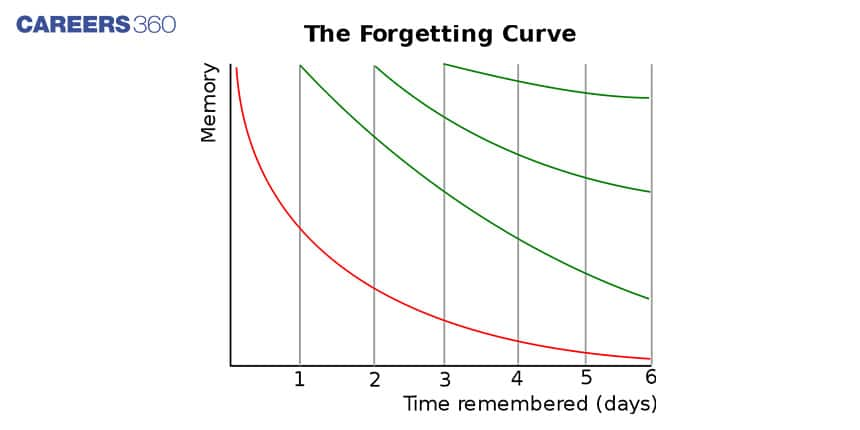This Is How Spaced Learning Can Help You Retain Anything You Learn
It was in the year 1885, that German psychologist, Hermann Ebbinghaus, first proposed the Forgetting Curve and the spacing effect . This was also when the idea of spaced learning first emerged. The strength of memory is a related idea that describes how long memory traces last in the brain. The stronger the memory, the longer the period of time that a person is able to recall it.

Forgetting Curve
The forgetting curve postulates a decline in memory retention over time. This curve illustrates how information is lost over a period of time when no effort is made to keep it. According to a typical forgetting curve graph, if people don't consciously review what they've learned, they will forget half of what they've just learned within a few days or weeks. The forgetting curve supports transience, one of the seven types of memory failure, which is the forgetting process that happens over time.
Hermann Ebbinghaus proposed the theory that the rate of forgetting is influenced by a variety of factors, including the difficulty of the learnt material (such as how meaningful it is), how it is represented, and other physiological factors like stress and sleep. He also proposed that there are few differences in basal forgetting rates of people. He came to the conclusion that mnemonic representation skills could account for the differences in performance. He continued by speculating that those differences could be partially overcome by some basic training in mnemonic techniques and strategies.
How Can We Increase Learning Retention?
He asserts that by repeating instructions at regular intervals, learning retention can be maximised. He claimed that the following techniques are the most effective for improving memory strength:
improved memory representation, such as using mnemonics
repetition, which is based on active recall (especially spaced repetition).

Fig : Forgetting Curve with Spaced Repetition
Near-Perfect Retention
In order to achieve near-perfect retention, initial repetitions of spaced repetition may need to be made within days, but later repetitions can be made years later. This was the underlying tenet of his theory. He claimed that each repetition in learning increases the optimum interval before the next repetition is needed. The forgetting curve was flattened by repetition, and he discovered that information is easier to recall when it is built upon prior knowledge. The information should be reinforced through repeated recall by applying frequent training in learning.
For instance, if you start to remember the multiplication tables or the square and cube roots, try to recall them within a day and then retake the exercise. After that, you can review what you learned a week later, a month later, and finally years later. Then it will be stored in long-term memory, so you won't have to remember them every day.
Flashbulb Memory
Some memories are immune to the negative effects of interference and do not always follow the typical forgetting curve because different noise and environmental factors affect what information is remembered.
For example, some proponents assert that memories of shocking events like the Rajiv Gandhi assassination or 9/11 are vividly imprinted in memory, a concept known as "flashbulb memory."
Spaced Learning:
Educational failures often reflect problems in retaining information over time, rather than in acquiring the information in the first place. Building memories requires a structural shift in the brain. Chemical changes support short-term memory, whereas structural or physical changes are necessary for long-term memories because they require time.
Dr Lara Boyd, a brain scientist at the University of British Columbia, asserts that the best driver of the neuroplastic changes in the brain is behaviour. The problem with this is that it takes a lot of practice, or behaviour, to make structural changes in your brain and commit new or rebuilt motor skills to long-term memory. Behaviour or practice are the most powerful tools. Research has shown that our behaviour affects how our brains function.
Increased struggle and difficulty during practice result in both learning and a bigger structural change in your brain.
Your next thought must be: "How do I practice?" or "How many doses of practice or behaviour are needed for learning?" That's what spaced learning is about.
Spaced learning meaning - a teaching strategy in which the condensed learning material is repeated three times, with two 10-minute breaks during which the students engage in activities like physical activity or any other distractor. Or to put it another way, just as your study session consists of 3 spaced repetitions with 2 breaks, spaced learning is simply spaced repetition learning with another set of repetitions. This method of instruction helps students retain the material being covered in the class.
The repetition of concepts is a vital component of spaced learning. According to Kelley and Whatson (2013), memory systems choose the information to permanently encode from environmental stimuli. Long-term memory encoding can begin with repeated stimuli separated by timed gaps or spaced practice without stimuli to memorise and improves long-term learning and recall.
Spaced Learning Examples: It is more effective to practice learning tables and formulas for 3 hours by taking two breaks of 10 minutes after every 50 minutes rather than learning continuously for 3 hours.
How To Use The Spaced Learning Method?
Read the material you want to learn or try to picture each piece of information for a few seconds before moving on to the next in your head by using your imagination. Don't spend more time than necessary doing it.
For 10 minutes, divert your attention with television, music, movies, sculpture, painting, or any activity containing no academic stimuli that engages your visual or spatial brain. Its primary objective is to calm the learner, effectively turning away any thoughts of what he has just finished learning from his mind. This step might seem pointless, but it is necessary if you want the information to stay in your long-term memory.
Try to remember the information you're attempting to learn. You'll probably need to reread it because it didn't come to you easily the first time. It's okay; just go over it again and try to recall any details that slipped your mind.
Depending on how much you're trying to learn, repeat the recall and distraction steps as often as you like. In most cases, three recalls should be sufficient, but if you're trying to memorise more than 300 things, it is advised to break it up into multiple sessions. According to neuroscientists, three recalls with two distractions are all that is required, but repeat until it becomes easy.
How Does Spaced Learning Differ From The Spaced Repetition Study Method?
The concepts behind the spaced repetition method and spaced learning are similar in that they both aim to improve recall over time.
spaced repetition meaning: It is a method of reviewing learning material at regular intervals where the intervals can be of your choice, unlike spaced learning.
But the spaced repetition method doesn't engage the visual or spatial regions of the brain. For spaced repetition to be effective, it requires a lot of repetitions because the neural connection is so weak every time. It only takes three recalls before the long-term memory is formed because activating the visual/ spatial centres is what does most of the work. Based on the spaced repetition algorithm, spaced repetition software employs the spaced repetition techniques, which involves gradually introducing more challenging material while presenting easier material less frequently. Spaced repetition is essential to your training program because it speeds up learning and frees up time for production.
Spaced repetition example: Instead of a 12-hour marathon cramming session, use spaced repetition for 1 to 2 hours every other day, or at least once per week.
In spaced learning, by adding distractions and engaging the visual/spatial area of the brain, the neural connection is strengthened. The visual or spatial aspect is the same principle that mind palaces rely on.
The Significance Of Spaced Studying
Spaced learning has been reported to enhance long-term memory creation, which forms the basis for its use in education. Studies have proved that the spaced repetition method enhances long-term retention by around 200 per cent.
Makes learning easy and fewer load
Improves learning.
store information in our memory in a manner that makes the information more resistant to change.
Make the learning concepts more interesting.
Studying more efficiently by not wasting time.
Learners can access study materials whenever they want.
